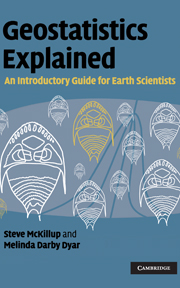Book contents
- Frontmatter
- Contents
- Preface
- 1 Introduction
- 2 “Doing science”: hypotheses, experiments and disproof
- 3 Collecting and displaying data
- 4 Introductory concepts of experimental design
- 5 Doing science responsibly and ethically
- 6 Probability helps you make a decision about your results
- 7 Working from samples: data, populations and statistics
- 8 Normal distributions: tests for comparing the means of one and two samples
- 9 Type 1 and Type 2 error, power and sample size
- 10 Single-factor analysis of variance
- 11 Multiple comparisons after ANOVA
- 12 Two-factor analysis of variance
- 13 Important assumptions of analysis of variance, transformations and a test for equality of variances
- 14 Two-factor analysis of variance without replication, and nested analysis of variance
- 15 Relationships between variables: linear correlation and linear regression
- 16 Linear regression
- 17 Non-parametric statistics
- 18 Non-parametric tests for nominal scale data
- 19 Non-parametric tests for ratio, interval or ordinal scale data
- 20 Introductory concepts of multivariate analysis
- 21 Introductory concepts of sequence analysis
- 22 Introductory concepts of spatial analysis
- 23 Choosing a test
- Appendices
- References
- Index
20 - Introductory concepts of multivariate analysis
Published online by Cambridge University Press: 05 June 2012
- Frontmatter
- Contents
- Preface
- 1 Introduction
- 2 “Doing science”: hypotheses, experiments and disproof
- 3 Collecting and displaying data
- 4 Introductory concepts of experimental design
- 5 Doing science responsibly and ethically
- 6 Probability helps you make a decision about your results
- 7 Working from samples: data, populations and statistics
- 8 Normal distributions: tests for comparing the means of one and two samples
- 9 Type 1 and Type 2 error, power and sample size
- 10 Single-factor analysis of variance
- 11 Multiple comparisons after ANOVA
- 12 Two-factor analysis of variance
- 13 Important assumptions of analysis of variance, transformations and a test for equality of variances
- 14 Two-factor analysis of variance without replication, and nested analysis of variance
- 15 Relationships between variables: linear correlation and linear regression
- 16 Linear regression
- 17 Non-parametric statistics
- 18 Non-parametric tests for nominal scale data
- 19 Non-parametric tests for ratio, interval or ordinal scale data
- 20 Introductory concepts of multivariate analysis
- 21 Introductory concepts of sequence analysis
- 22 Introductory concepts of spatial analysis
- 23 Choosing a test
- Appendices
- References
- Index
Summary
Introduction
So far, all the analyses discussed in this book have been for either univariate or bivariate data. Often, however, earth scientists need to analyze samples of multivariate data – where more than two variables are measured on each sampling or experimental unit – because univariate or bivariate data do not give enough detail to realistically describe the material or the environment being investigated.
For example, a large ore body may contain several different metals, and the concentrations of each of these may vary considerably within it. It would be useful to have a good estimate of this variation because some parts of the deposit may be particularly worth mining, others may not be worth mining at all, or certain parts may have to be mined and processed in different ways. Data for only one or two metals (e.g. copper and silver) are unlikely to be sufficient to estimate the full variation in composition and value within a deposit that also includes lead and zinc.
Samples on which multivariate data have been measured are often difficult to compare with one another because there are so many variables. In contrast, samples where only univariate data are available can easily be visualized and compared (e.g. by summary statistics such as the mean and standard error). Bivariate data can be displayed on a two-dimensional graph, with one axis for each variable. Even data for three variables can be displayed in a three-dimensional graph.
- Type
- Chapter
- Information
- Geostatistics ExplainedAn Introductory Guide for Earth Scientists, pp. 270 - 296Publisher: Cambridge University PressPrint publication year: 2010



